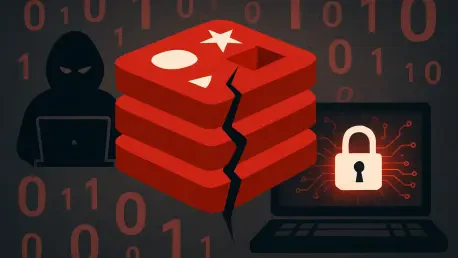In an era where data breaches and cyber threats dominate headlines, a staggering revelation has emerged about Redis, a popular open-source, in-memory data storage platform relied upon by countless organizations for high-speed caching and database operations. A critical vulnerability, lurking undetected for over a decade, now endangers approximately 60,000 internet-exposed Redis servers that lack basic authentication. Identified as CVE-2025-49844 and ominously nicknamed “RediShell,” this flaw has earned a perfect CVSS score of 10/10, signaling its potential to wreak havoc through remote code execution. As industries increasingly depend on cloud environments—where 75% of setups utilize Redis—the scale of this risk cannot be overstated. This alarming situation underscores a pressing need for immediate action to protect vital digital infrastructure from devastating compromises.
Unveiling the Vulnerability’s Scope and Impact
Exploring the Technical Depth of RediShell
A deep dive into the nature of CVE-2025-49844 reveals a use-after-free vulnerability nestled within Redis’s Lua interpreter, a component integral to executing scripts for enhanced functionality. This flaw allows authenticated attackers to exploit the system by sending malicious Lua scripts, which can break out of the secure sandbox environment designed to contain them. Once outside this boundary, attackers gain the ability to execute arbitrary code, potentially leading to full system control. The consequences could be catastrophic, ranging from deploying reverse shells to harvesting sensitive credentials or installing malware. Given that Redis often operates in environments handling critical data, such an exploit could ripple through entire networks, amplifying the damage. The fact that this issue has persisted undetected for years only heightens the urgency for organizations to understand its mechanics and prioritize defensive strategies against such sophisticated threats.
Assessing the Scale of Exposed Systems
The sheer scale of exposure tied to this vulnerability paints a grim picture for global cybersecurity. Of the roughly 330,000 Redis servers accessible online, an estimated 60,000 operate without any authentication, leaving them as prime targets for exploitation. This widespread lack of protection stems largely from Redis’s default configuration, which assumes deployment in secure, internal environments and thus does not enforce authentication by default. Compounding the problem, the Lua scripting feature—enabled out of the box—provides a direct pathway for attackers to exploit the flaw. Even in internal setups where authentication might be overlooked, adversaries with initial access can leverage this vulnerability for lateral movement, accessing sensitive data or escalating privileges. Such extensive exposure highlights a systemic issue in how open-source tools are deployed, often prioritizing ease of use over robust security, and demands a reevaluation of configuration practices across industries.
Mitigation Strategies and Industry Response
Immediate Actions for Securing Redis Instances
Responding to this critical threat, Redis released patched versions on October 3, covering multiple branches such as 7.22.2-12, 7.8.6-207, and OSS/CE versions like 8.2.2, to address the vulnerability. Cloud deployments benefited from automatic updates, but self-managed instances require urgent manual upgrades to ensure protection. Beyond patching, several security measures are recommended to fortify systems against potential exploits. Restricting network access, enabling protected mode, and enforcing strong authentication stand as fundamental steps to reduce risk. Additionally, limiting permissions, deploying firewalls, and restricting Lua script execution to trusted users can further safeguard environments. Continuous monitoring for unauthorized access, unusual traffic patterns, or unexpected crashes in the Lua engine is also advised to detect early signs of compromise. These proactive steps are essential for organizations to shield their infrastructure from the severe implications of this long-standing flaw.
Broader Implications for Open-Source Security
The emergence of this Redis vulnerability has sparked a wider conversation about security practices in open-source software, particularly concerning default configurations and public exposure. Industry experts stress the need for safer default settings that prioritize security over convenience, alongside stronger firewall protections to minimize internet-facing risks. Continuous asset discovery and exposure management are also critical to identify and secure vulnerable instances before they can be targeted. Behavioral monitoring at both endpoint and network levels offers another layer of defense, helping to spot anomalies indicative of exploitation. This situation serves as a reminder of the shared responsibility between software providers and users to address systemic challenges in deployment practices. As open-source tools like Redis remain integral to modern IT environments, fostering collaboration and adopting robust security hygiene will be key to mitigating future threats of this magnitude.
Reflecting on Lessons Learned
Looking back, the response to CVE-2025-49844 underscored the critical intersection of software vulnerabilities, misconfigurations, and expanding attack surfaces in digital ecosystems. Patched versions were swiftly rolled out, and actionable guidance was provided to secure systems, yet the incident exposed deeper flaws in how widely used tools were often deployed without adequate safeguards. The absence of active exploitation at the time offered a narrow window of relief, but the risk to tens of thousands of servers lingered as a stark warning. Moving forward, organizations were urged to not only apply immediate fixes but also to invest in long-term strategies like regular audits, updated security protocols, and enhanced training on secure configurations. This event became a catalyst for rethinking the balance between functionality and security in open-source adoption, emphasizing that proactive management and industry-wide cooperation were vital to protecting critical infrastructure against evolving cyber threats.









